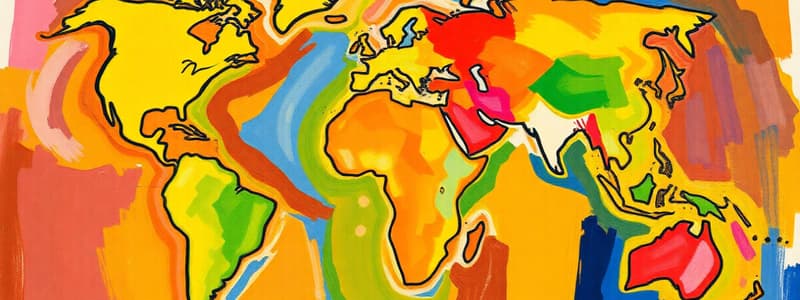Podcast
Questions and Answers
What significant legal framework was established during the Byzantine Empire under Emperor Justinian?
What significant legal framework was established during the Byzantine Empire under Emperor Justinian?
- The Napoleonic Code
- The Magna Carta
- The Justinian Code (correct)
- The Twelve Tables
Which of the following best describes the role of the Church in Western Europe after the Fall of the Roman Empire?
Which of the following best describes the role of the Church in Western Europe after the Fall of the Roman Empire?
- It operated independently from the local communities.
- It became a central institution in political, social, and cultural life. (correct)
- It was primarily focused on promoting trade and commerce.
- It functioned solely as a religious institution with no political influence.
What was a key difference between universal religions like Christianity, Buddhism, and Islam compared to ethnic religions?
What was a key difference between universal religions like Christianity, Buddhism, and Islam compared to ethnic religions?
- Universal religions do not promote a set of moral values.
- Universal religions are exclusive to certain geographical areas.
- Universal religions seek to appeal to all people, regardless of background. (correct)
- Universal religions focus mainly on local customs and ethnic identities.
Which factor significantly influenced the spread of Islam in pre-Islamic Arabia and beyond?
Which factor significantly influenced the spread of Islam in pre-Islamic Arabia and beyond?
How did gender roles in pre-Islamic Arabia contrast with those defined during the Islamic empires?
How did gender roles in pre-Islamic Arabia contrast with those defined during the Islamic empires?
What was the primary philosophical principle that justified the rule of the Zhou Dynasty in China?
What was the primary philosophical principle that justified the rule of the Zhou Dynasty in China?
Which concept in Hinduism emphasizes moral duty and the right way of living?
Which concept in Hinduism emphasizes moral duty and the right way of living?
Which of the following achievements is most closely associated with the Gupta Dynasty in classical India?
Which of the following achievements is most closely associated with the Gupta Dynasty in classical India?
What significant political structure characterized the Roman Empire during its height?
What significant political structure characterized the Roman Empire during its height?
What was a key factor in the decline of the Han, Roman, and Gupta Empires?
What was a key factor in the decline of the Han, Roman, and Gupta Empires?
What is the composition of the AP World midterm exam?
What is the composition of the AP World midterm exam?
What is a recommended method for studying for the AP World midterm?
What is a recommended method for studying for the AP World midterm?
During what period does the content discuss the transition from hunting and gathering to civilization?
During what period does the content discuss the transition from hunting and gathering to civilization?
What must students bring to the AP World midterm?
What must students bring to the AP World midterm?
What type of questions should students prepare for in the short-answer section of the midterm?
What type of questions should students prepare for in the short-answer section of the midterm?
What is one key aspect of river valley civilizations that students should understand?
What is one key aspect of river valley civilizations that students should understand?
When is the extra help session scheduled for review before the midterm?
When is the extra help session scheduled for review before the midterm?
What do students need to prepare in addition to factual content for the midterm?
What do students need to prepare in addition to factual content for the midterm?
Flashcards
Neolithic Revolution
Neolithic Revolution
The period of time when humans transitioned from hunting and gathering to agriculture, leading to significant changes in human societies and the development of civilizations.
River Valley Civilizations
River Valley Civilizations
The civilizations that emerged in the river valleys of Mesopotamia, Egypt, Indus, and China, characterized by advancements in agriculture, writing, urban centers, and organized governments.
Spread of Agriculture
Spread of Agriculture
The spread of agriculture from its origins in the Fertile Crescent to other parts of the world. This process involved both the movement of people and the diffusion of agricultural techniques and crops.
Code of Hammurabi
Code of Hammurabi
Signup and view all the flashcards
Epic of Gilgamesh
Epic of Gilgamesh
Signup and view all the flashcards
Ten Commandments
Ten Commandments
Signup and view all the flashcards
Compare and Contrast
Compare and Contrast
Signup and view all the flashcards
Classical Period
Classical Period
Signup and view all the flashcards
Mandate of Heaven
Mandate of Heaven
Signup and view all the flashcards
Confucianism
Confucianism
Signup and view all the flashcards
Daoism
Daoism
Signup and view all the flashcards
Legalism
Legalism
Signup and view all the flashcards
Qin Shi Huangdi
Qin Shi Huangdi
Signup and view all the flashcards
Shia-Sunni Split
Shia-Sunni Split
Signup and view all the flashcards
Post-Classical Period
Post-Classical Period
Signup and view all the flashcards
Feudalism
Feudalism
Signup and view all the flashcards
Byzantine Empire
Byzantine Empire
Signup and view all the flashcards
Universal Religion
Universal Religion
Signup and view all the flashcards
Study Notes
AP World History I - Midterm Review 2025
- Midterm Format: 55 multiple-choice questions, 3 short-answer questions (SAQs). Some questions may include stimuli.
- Study Strategies: Create your own study guide using provided guiding questions. Utilize unit 1-4 review materials. Review class notes, readings, and documents. Create a vocabulary list and use flashcards or an app to aid in memorization. Be responsible for vocabulary words and words defined in context; definitions/context will not be provided during the midterm.
- Materials Needed: Pen and pencil. Scantron must be filled out in pencil, with written answers in pen.
- Extra Help/Review: Extra help will be available with each teacher. Specific questions should be prepared. A review will occur on January 15th at 7:00 AM in the Little Theater, requiring students to prepare questions for the session.
- Hunting and Gathering to Civilization (2.5 Million to 600 BCE): Analyze the spread of agriculture. Examine the fundamental changes to human society brought about by the Neolithic Revolution. Detail the key aspects and characteristics of river valley civilizations. Consider important ancient texts (e.g., Code of Hammurabi, Epic of Gilgamesh, 10 Commandments). Compare and contrast political, economic, and social structures among river valley civilizations.
Classical Period (600 BCE to 600 CE)
- Classical China (Zhou, Qin, and Han): Understand the mandate of heaven and dynastic cycle, Confucianism, Daoism, and Legalism. Compare and contrast the three philosophies. Analyze changes and continuities of political, economic, and social structures from the Zhou to the Han dynasties.
- Classical India (Maurya and Gupta): Discuss the impact of geography on Indian political institutions. Analyze the roles and impacts of key figures like Chandragupta Maurya and Ashoka and their spread of Buddhism. Examine the cultural and intellectual achievements during the Gupta period, including religions and belief systems like Hinduism (Karma, Dharma, Reincarnation, Caste System, Upanishads, Moksha) and Buddhism (Siddhartha Gautama, Four Noble Truths, Eightfold Path, Nirvana).
- Classical Mediterranean (Greece and Rome): Compare and contrast the cultural and political values of Athens and Sparta. Understand the role of Pericles and democracy. Analyze the impact of Alexander the Great and the Hellenistic Age. Compare the achievements and policies of the Han, Roman, and Gupta empires, including citizenship concepts, "bread and circuses", and considerations on trade, view of merchants, and religious tolerance/spread.
Post-Classical Period (600 CE to 1450 CE)
- Islamic World: Define and analyze pre-Islamic Arabia, Muhammad, the Five Pillars of Islam, Umma, Dhimmi, and Mawali. Analyze the Umayyad and Abbasid Dynasties, social hierarchies, scholarship, and learning, Sunni vs. Shi'ite (Shia) Split, the spread of Islam, and role of conquest.
- Post-Classical Europe: Understand the fall of the Roman Empire, role of the Church. Analyze the Byzantines' relationship to Roman legacy, Hagia Sophia, Emperor Justinian's Justinian Code, Byzantine influence in Kievan Rus, and feudalism/manorialism .
- Universal Religions: Compare and contrast Christianity, Buddhism, and Islam, including their spread, key tenants, and impact.
- Gender Roles: Assess how gender roles were perceived in various societies, law codes, philosophies, religion, and economics. Analyze interactions between cultures and impact of geography.
- Overarching Course Themes: Analyze and synthesize impacts of interaction, technology, demography, social and gender structures, cultural and intellectual developments across societies.
Studying That Suits You
Use AI to generate personalized quizzes and flashcards to suit your learning preferences.




